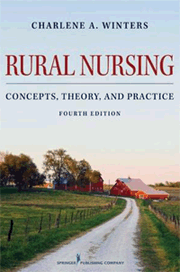full article:
 | Rural Nursing: Concepts, Theory and Practice (fourth edition) Springer Publishing Company, New York, 2013 |
Rural Nursing: Concepts, Theory and Practice is the fourth edition of a text that is both timely and comprehensive. Content focuses on rural-based nursing practice, education and research, the health of rural dwellers and the provision of health care in rural settings. It retains the classic chapters which have been updated and combines them with new chapters that expand the paradigm of rural nursing from a national and international perspective.
This text adds to our understanding of evidence-based care and theory structure. Designed for nurse educators and graduate students, it will also be useful to nurses in a variety of settings, nurse managers and policy-makers whose work addresses rural health issues.
There are 30 chapters divided into six parts which have been retained from earlier editions. Part I, 'The Rural nursing theory base', is anchored with the distinguished and pioneering work of Long and Weinert (1989) on the development of the rural nursing theory base. The new chapter is Molinari and Guo's 'Rural nursing theory: a review of the literature'. Their discussion, related to the challenges of working with various search engines, will be particularly helpful to graduate nursing students.
Part II, 'Perspectives of rural persons', includes two new chapters. Wagneld and Torma report on a preliminary study assessing resilience in older frontier women. Responses of the participants from the qualitative part of the research that were included in this chapter illustrate that elderly frontier women are resilient and healthy. These findings are relevant to healthcare practitioners in a wide variety of settings. The purpose of the second new chapter, 'Palliative care at the end of life', is to connect the 'real world' practice setting of rural palliative care with the existing palliative care literature. Mayer and Murphy utilized a case study of an elderly ranching couple to describe both the challenges and opportunities of rural end-of-life palliative care. Nurses and other members of the multidisciplinary team may wish to consider using this chapter as a blueprint for developing and sustaining rural-based palliative care programs.
'Health disparities in rural populations across the life span' is the new chapter in Part III, 'The rural dweller and response to illness'. Bushy examines the concepts of risk, vulnerability and social determinants relative to health disparities. Children and adolescents, the elderly, women and the disenfranchised are four rural populations that are particularly vulnerable. Bushy presents a brief overview of concerns for each of these four populations. Graduate students and rural nursing scholars will find this chapter rich in topics for potential research studies. Nurses that are new to rural community health nursing will also gain a much-needed understanding of rural-based health disparities.
The new chapters in Part IV, 'Rural nursing practice and education', expand the scope of the text by profiling two rural populations - the US/Mexico border (La Frontera) population and the international community of Haiti. Moya et al, in 'U.S. Mexico border: challenges and opportunities in rural and border health', describe the breadth of challenges with respect to health status, entitlements, utilization and access to care. They discuss the unique opportunity that nurses practicing in this region have for putting into action care that is comprehensive in nature and reflects the consideration and respect to the beliefs and practices of all residents. Innovations in the delivery of care that address the issues that have been identified are introduced. Researchers and multidisciplinary healthcare teams may consider replicating these to address similar needs in other rural communities.
Michelle Sare arrived for her first time in Haiti just 40 minutes before the devastating earthquake in January, 2010. Her chapter, 'Reestablishing nursing education in Haiti: nurses helping nurses after complex humanitarian emergencies', is a compelling and compassionate narrative of the people of Haiti, needs of marginalized populations and the implications for rural nursing education. In addition, the links between rural nursing theory as described by Long and Weinert (1989) and the observations of relevance to Haitian rural dwellers are presented in a very helpful table format. It is a unique and outstanding work and will touch the heart of each reader.
Sare is also the contributor to one of the two new chapters in Part V, 'Rural public health'. The chapter 'Public health accreditation in rural and frontier counties: a Montana perspective' is also a narrative that includes tables that are advantageous in distilling key content. An expanded view of rural nursing practice in the north-eastern part of the country is the focus of the second new chapter, 'Nurses in occupational practice in agricultural and rural communities in New York state: providing occupational health and safety education and prevention services'. Hodge et al describe the interdisciplinary New York Center for Agricultural Medicine and Health and report on the essential services provided by rural occupational health nurses in upstate New York. The breadth and scope of rural-based occupational nursing practice includes non-traditional settings that will be of interest in all geographical areas.
Part VI, 'Looking ahead', includes a new chapter, 'Nursing workforce development, clinical practice, research, and nursing theory: connecting the dots'. Bushy and Winters focus on the state of the rural nursing workforce and its impact on nursing practice, research and theory development. Rural considerations are added to each of the eight recommendations of the Institute of Medicine's Future of Nursing document.
The strength of this text lies in the broad spectrum of content addressed, the scholarly presentation and depth of the material and the expertise of the authors. It addresses interdisciplinary approaches, teams and collaborative practice in numerous chapters. These would be an appropriate teaching tool in interprofessional healthcare education. It would be helpful for a future edition to address ethical issues in rural health care.
Jamie Anderson, MS, MA
Director, Rural Medical Education
University of Nevada School of Medicine
Nevada, USA
